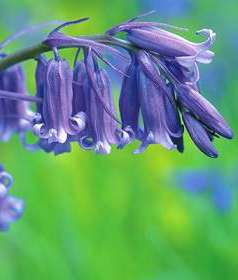 The Guardian
The Guardian is concerned that this typically English flower "is being genetically contaminated by the Spanish bluebell, a favourite with gardeners."
They remind us of the feats of this beautiful flower:
With the power to summon fairies and inspire poets, it is a quintessential symbol of the British springtime.And they even remember to quote Emily's lines:
Its blossoms have the mightiest power to soothe my spirit's care," wrote Emily Bronte in her poem about "the sweetest flower".Both
Emily and
Anne Brontë have poems in praise of the bluebell, though our edition of The Tenant of Wildfell Hall by Kathryn White (Assistant curator/librarian of the Brontë Parsonage Museum at the time) argues that:
Anne probably meant harebells, which flower in the summer. Both she and Emily seem to have confused the two flowers, as each wrote a poem entitled 'The Bluebell' in which the descriptions of the flower suggest a harebell.(In The Tenant of Wildfell Hall bluebells seemeingly appear out of season both in chapter 15 and 29).
The
wikipedia tells us, however, that harebells were previously known as bluebells. So that would make sense as far as the Brontës are concerned, though the poems wouldn't be useful for The Guardian's purpose any more. Oh well, judge for yourselves. Those two poems are extremely beautiful, which, in our humble opinion, is what matters at the end of the day. And Emily and Anne would be happy to help preserve a flower, whether they were inspired by it or not.
Confusing, huh?
Categories: In_the_News, Poetry, Emily_Brontë, Anne_Brontë









0 comments:
Post a Comment